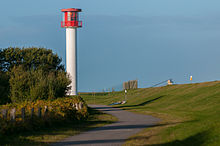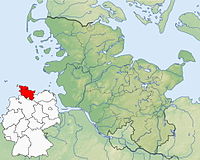 | ||
| Office of the Probstei | ||
| federal state | Schleswig-Holstein | |
|---|---|---|
| Residents | 21.735 (2018) | |
| height | unknown | |
| no value for height on Wikidata: | ||
| no tourist info on Wikidata: | ||
| location | ||
| ||
The Probstei is in the eastern part of Schleswig-Holstein and northeast of the state capital Kiel. The holiday region roughly covers the area between Laboe in the west, the Baltic Sea in the north (Kiel Bay), the villages of Stakendorf and Bendfeld in the west and Probsteierhagen, Passade, Fahren and Stoltenberg in the south.
Regions

- The Baltic coast the provost is about 20 km long. The Baltic seaside resort Laboe and Schoenberg, the resorts of Stein and Wendtorf as well as the Wischer district of Heidkate and Stakendorfer Strand are among the best-known seaside resorts.
- The rural provostry offers an intact natural landscape with original villages and wide (grain) fields.
places



- Barsbek - in spring crocus blooms on the village green
- Bendfeld - many old Lower Saxony houses
- Brodersdorf - informative tree adventure trail
- Drive - stately courtyards on the Passader lake
- Fiefbergen - annual cycle race "Fiefbergen Rund"
- Höhndorf / Gödersdorf - Craft village on the edge of the provost's office
- Krokau - Location of a grindable windmill
- Krummbek - well-known gastronomy and court slaughter
- Laboe - Ostseebad on the foothills of the Kiel Fjord, known for the naval memorial with submarine
- Lutterbek - idyllic village with an old blacksmith's shop and cultural meeting place
- Passade - award-winning village on the lake
- Prasdorf - Riding stables and farm holidays
- Probsteierhagen - Hagen Castle and St. Catherine's Church
- Schoenberg - Baltic seaside resort with the districts of California and Brazil
- Stakendorf - Beach and lovely village center
- stone - family-friendly resort on the Baltic Sea
- Stoltenberg - Agricultural community on the Passader See
- Wendtorf - Resort with a beach and a sailing port
- Wipe - the oldest village of the provost with a beach on the Baltic Sea in Heidkate
Other goals
background
The provost office extends over an area of 133 km² in the Plön district. The population is around 21,000 people.
In 1226, the then sovereign, Count Adolf IV of Schauenburg, donated the northern part of today's Plön district to the Benedictine monastery in Preetz so that it could be settled and Christianized from there. In the documents of the head of the monastery, also called "Provost", this area was referred to as "Klösterlich Preetzer Propstei" and its inhabitants as "the Propsteier". Over the centuries the "Propstei" became the current name "Probstei".
The probsteier farmers, who mostly managed their farms as owners or on their own lease, were privileged compared to the serf farmers of the surrounding manors, because they were obliged to pay relatively little taxes and services to the monastery, but were personally absolutely free. Considerable prosperity developed over the centuries, which - not least due to the personal freedom of the probationers - gave rise to a population whose independence and pride are very pronounced. After 1867 Schleswig-Holstein was annexed to the state of Prussia, the Preetz monastery rule ended.
Today the Probstei is a modern, agricultural and especially touristic part of the Plön district, whose municipalities Barsbek, Bendfeld, Brodersdorf, Fahren, Fiefbergen, Höhndorf with Gödersdorf, Köhn with Pülsen, Krokau, Krummbek with Ratjendorf, Laboe, Lutterbek, Passade, Prasdorf, Probsteierhagen, Schoenberg, Stakendorf, Stein, Stoltenberg, Wendtorf and Wisch mit Heidkate is administered by the Probstei office.
The region shaped by nature belongs to the northwestern part of the East Holstein hill country, which was formed by the last ice age around 15,000 years ago. After the ice had thawed, lakes such as the Passader See or the Selenter See near Köhn, mostly flat, wavy terminal moraine landscapes, such as between Bendfeld, Krummbek, Krokau and Barsbek, typically Holstein hilly landscapes, such as at Fahren and Stoltenberg, areas more flat, below sea level Salt marshes, as the interface between the sea and the mainland, as well as a beach area over 20 km long between the Baltic seaside resorts of Laboe, Stein, Wendtorf, Wisch / Heidkate via Schönberg to the freshwater and saltwater biotope on Stakendorfer Strand emerged. The fertile soil is used intensively for growing grain. It is no coincidence that the Probstei has always been considered the "granary" of the entire region and the Probsteier grain was in demand as a seed at home and abroad centuries ago and was, for example, after Scandinavia and Russia shipped.
language
getting there
- Car: Autobahn A 7 via Hamburg to the Bordesholm junction, then continue on the A 215 to Kiel. There follow the signs "B76 - Lübeck" and "Ostuferhafen", later B 502 "Laboe" or "Schönberg". Or via the A 1 in the direction of Lübeck, then A 21 in the direction of Kiel.
- Train & bus: Arrival by train via Hamburg to Kiel Hbf. Then continue from the stop "Hauptbahnhof" (directly opposite) with lines 200/201 and 210 in the direction of "Schönberg" or with line 100/102 to Laboe.
- ship: There is a regular ferry connection from Kiel to Laboe. In addition, excursion steamers leave the Schönberger Strand pier in the summer months.
- bicycle: The Baltic Sea Cycle Route leads directly along the coastline through the Probstei.
mobility
Tourist Attractions


- Krokauer Mill - a fully grindable basement Dutch mill from 1872
- Probsteier grain days - Rural program of events from the end of July to the end of August with the stout straw figure competition
- Submarine 995 on the beach of Laboe - memorial and technical museum
- Marine Memorial in Laboe - memorial and THE face of the Kiel Outer Fjord
- Hagen Castle in Probsteierhagen - mansion with culture and event center
- Probstei museum harbor in Wendtorf - shows fishing vessels from the 19th century
- Old Lutterbeker forge - from 1628 shows old and new blacksmithing
- Museum station on Schönberger Strand - old locomotives, wagons and trams
- Probstei Museum in Schönberg - shows the living and working world of its former residents
- Childhood Museum in Schönberg - shows different childhoods in the course of the last 100 years
activities

- Swimming: The Probstei has a nearly 20 km long Baltic Sea beach, which extends from Laboe extends to Stakendorf. You will find fine sandy beaches, natural beaches, cliffs, dog beaches, nudist beaches, guarded and unguarded beaches, sections that are free and subject to health tax, beach chairs, water sports ...
- To go biking: Diverse landscapes, fields, forests and lakes, plus the long stretches along the Baltic Sea coast, courtyard cafes and cultural sights. The route network is well developed and signposted. In addition to the Baltic Sea Cycle Route, there are three thematic cycle routes through the provost, namely the Maritime Route (61 km), the Culture Route (58 km) and the Nature Route (60 km)
- horse riding: Riding holidays, hourly rides, day rides, trail riding. In spring through the rapeseed fields, in autumn and winter on the Baltic Sea beaches ...
- Hiking & walking: Numerous paths far away from the main roads offer hikers ideal conditions to discover the provost on foot.
- water sports: There are a total of six water sports schools on the Probstei's Baltic coast. Surf and kite courses, SUP, boat rental, motorboat driving licenses, pedal boats or banana rides. Water skiing is also possible on the Passader See.
- fishing: The great diversity of water in the provost makes it possible: Herring can be caught in many places, especially in spring, and surf fishing for cod, plaice and others in autumn and winter. You can also reproduce the many fish species in the fresh water in the inland waters, such as the Passader Lake, the cash ponds or the many small floodplains.
kitchen
The Probstei offers a rural atmosphere with numerous farms, country inns, farm cafes and fish smokers. You can get fresh milk, eggs from free-range chickens, meat and sausage, fruit and vegetables directly in the farm shops or at the weekly markets in Laboe and Schoenberg. Freshly caught fish can be bought directly from the cutter in the Marina Wendtorf.
nightlife
security
climate
In the provost there is a predominantly temperate climate. Rainfall is spread throughout the year, with the highest number of rainy days per month between November and March. You can expect most of the sunshine between May and August. Temperatures rise in spring from 2 degrees in January to an average of 21 degrees in July and August. Then the values drop back to 4 degrees in December, while in the autumn months of September and October it can still be quite mild with values above 15 degrees.
literature
- The Probstei - a portrait (by Werner Scharnweber)
- Fore and aft Diek (by Ute Haese and Torsten Prawitt)
- Bicycle and holiday map The Probstei
- The provost in words and pictures
Web links
- http://www.amt-probstei.de/ - Official website of Amt Probstei
- [the Schönberger beach]

